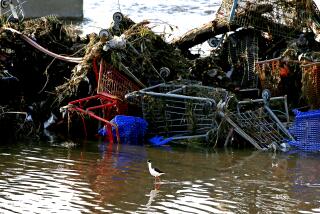Study Claims Fowl Are Fouling Water
- Share via
A team of UC Irvine researchers has concluded that waterfowl and other wildlife droppings from a saltwater marsh and the Santa Ana River are a significant source of bacteria contaminating the ocean waters off Huntington Beach.
In a report that will be published in the June 15 issue of Environmental Science and Technology, the researchers point to inherent flaws in the design of the man-made saltwater Talbert Marsh.
Stanley Grant, the professor who headed the 18-month study, said that once water containing fecal bacteria, pesticides, nutrients and other materials reaches the marsh, it filters through and into the ocean in about 40 minutes--which is too fast. For the marsh to act as a natural cleanser and remove contaminants, the water must spend at least a week filtering through the wildlife preserve, Grant said.
Even though other sources, such as urban runoff from the Santa Ana River, may have contributed to contamination that closed four miles of beach for most of the summer of 1999, the bacteria levels from the marsh were hundreds of times over the state limits, the researchers said.
The team’s conclusions contradict the accepted environmental theory that wetlands purify contaminated water flowing into the ocean. The findings suggest that approximately 4.6 million saltwater marshes in the United States could be similarly affected, Grant said.
Mark Gold, a spokesman for the Heal the Bay conservation group, said that finding animal droppings in a nature preserve is nothing new and insists that marshes still serve as a cleanser for other, more hazardous, contaminants.
“It’s not surprising that wetlands are sources of fecal bacteria,” Gold said. “What wetlands are great at doing is removing nutrients and metals.”
The 25-acre wetlands preserve is on the inland side of Pacific Coast Highway at Brookhurst Street. It attracts thousands of migratory birds and other wildlife each year, part of the Talbert watershed that encompasses 12 square miles in Huntington Beach and Fountain Valley.
The UC Irvine researchers also believe that the AES power plant contributes to the shore’s contamination. The study suggests that partially treated sewage released four miles offshore from the the Orange County Sanitation District treatment plant is being pulled back to the shore by tides and the plant as it draws water for cooling.
More to Read
Sign up for Essential California
The most important California stories and recommendations in your inbox every morning.
You may occasionally receive promotional content from the Los Angeles Times.









